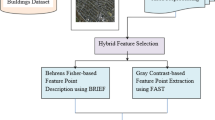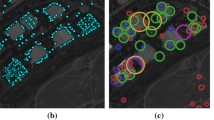Abstract
Building detection in orthophotos is crucial for various applications, such as urban planning and real-estate management. In order to realize accurate and fast building detection, a non-interactive approach based on binary feature classification is brought forward in this paper. The proposed approach includes two major stages, i.e., building area detection and building contours extraction. In the first stage, a sequence of intersections is obtained by superpixel segmentation in the subsampled orthophoto, and then building area is reserved roughly according to the classification of intersections. In the second stage, the sequence of intersections is updated by superpixel segmentation in the building area from original orthophoto, and then building contours is extracted in accordance with the classification of intersections likewise. The local feature of the intersections is descripted employing our extremely compact binary descriptor, and is classified using binary bag-of-features. Experiments show that benefiting from binary description and making full use of texture details and color channels, the proposed descriptor is not only computationally frugal, but also accurate. Experiments are also conducted on orthophotos with different roof colors, textures, shapes, sizes and orientations, and demonstrate that the proposed approach are capable of achieving desirable results.






Similar content being viewed by others
References
Achanta R, Shaji A, Smith K, Lucchi A, Fua P, Susstrunk S (2012) SLIC superpixels compared to state-of-the-art superpixel methods. IEEE Trans Pattern Anal Mach Intell 34(11):2274–2282
Alahi A, Ortiz R, Vandergheynst P (2012) FREAK: fast retina keypoint. In: IEEE Conference on computer vision and pattern recognition, Providence, USA, 16-21 Jun, pp 510–517
Bay H, Ess A, Tuytelaars T, Van Gool L (2008) Speeded-up robust features (SURF). Comput Vis Image Underst 110(3):346–359
Bruzzone L, Demir B (2014) A review of modern approaches to classification of remote sensing data. In: Manakos I, Braun M (eds) Land use and land cover mapping in Europe: practices and trends. Springer, Dordrecht, pp 127–143
Calonder M, Lepetit V, Ozuysal M, Trzcinski T, Strecha C, Fua P (2012) BRIEF: computing a local binary descriptor very fast. IEEE Trans Pattern Anal Mach Intell 34(7):1281–1298
Chang X, Nie F, Yang Y, Huang H (2014) A convex formulation for semi-supervised multi-label feature selection. In: AAAI Conference on artificial intelligence, Quebec City, Canada, 27-31 Jul, pp 1171–1177
Chang X, Nie F, Wang S, Yang Y, Zhou X, Zhang C (2016) Compound rank-k projections for bilinear analysis. IEEE Trans Neural Netw Learn Syst 27(7):1502–1513
Chang X, Ma Z, Yang Y, Zeng Z, Hauptmann AG (2017) Bi-level semantic representation analysis for multimedia event detection. IEEE Trans Cybern 47(5):1180–1197
Chang X, Yu YL, Yang Y, Xing EP (2017) Semantic pooling for complex event analysis in untrimmed videos. IEEE Trans Pattern Anal Mach Intell 39(8):1617–1632
Chang X, Ma Z, Lin M, Yang Y, Hauptmann AG (2017) Feature interaction augmented sparse learning for fast Kinect motion detection. IEEE Trans Image Process 26(8):3911–3920
Dornaika F, Moujahid A, Merabet M, Ruichek Y (2016) Building detection from orthophotos using a machine learning approach: an empirical study on image segmentation and descriptors. Expert Syst Appl 58:130–142
Ghamisi P, Dalla M, Benediktsson JA (2015) A survey on spectral spatial classification techniques based on attribute proles. IEEE Trans Geosci Remote Sens 53(5):2335–2353
Hu MK (1962) Visual pattern recognition by moment invariants. IRE Trans Inf Theory 8(2):179–187
Khurana M, Wadhwa V (2015) Automatic building detection using modified grab cut algorithm from high resolution satellite image. Int J Adv Res Comput Commun Eng 4(8):158–164
Lecun Y, Bengio Y, Hinton GE (2015) Deep learning. Nature 521:436–444
Leutenegger S, Chli M, Siegwart RY (2011) BRISK: binary robust invariant scalable keypoints. In: IEEE International conference on computer vision, Barcelona, Spain, 6-13 Nov, pp 2548–2555
Li Z, Gong W, Nee AYC, Ong SK (2009) Region-restricted rapid keypoint registration. Opt Express 17(24):22096–22101
Li Z, Gong W, Nee AYC, Ong SK (2009) The effectiveness of detector combinations. Opt Express 17(9):7407–7418
Liu L, Wiliem A, Chen S, Lovell BC (2014) Automatic image attribute selection for zero-shot learning of object categories. In: International conference on pattern recognition, Stockholm, Sweden, 24-28 Aug, pp 2619–2624
Liu L, Nie F, Zhang T, Wiliem A, Lovell BC (2016) Unsupervised automatic attribute discovery method via multi-graph clustering. In: International conference on pattern recognition, Cancun, Mexico, 4-8 Dec, pp 1713–1718
Liu L, Wiliem A, Chen S, Lovell BC (2017) What is the best way for extracting meaningful attributes from pictures? Pattern Recogn 64:314–326
Lowe DG (2004) Distinctive image features from scale-invariant keypoints. Int J Comput Vis 60(2):91–110
Ojala T, Pietikainen M, Harwood D (1996) Comparative study of texture measures with classification based on feature distributions. Pattern Recogn 29(1):51–59
Ojala T, Pietikainen M, Maenpaa T (2002) Multiresolution gray-scale and rotation invariant texture classification with local binary patterns. IEEE Trans Pattern Anal Mach Intell 24(7):971–987
Passino KM (2002) Biomimicry of bacterial foraging for distributed optimization and control. IEEE Control Syst Mag 22(3):52–67
Rosin PL (1999) Measuring corner properties. Comput Vis Image Underst 73(2):291–307
Rother C, Kolmogorov V, Blake A (2004) Grabcut: interactive foreground extraction using iterated graph cuts. ACM Trans Graph 23(3):309–314
Rublee E, Rabaud V, Konolige K, Bradski G (2011) ORB: an efficient alternative to SIFT or SURF. In: IEEE International conference on computer vision, Barcelona, Spain, 6-13 Nov, pp 2564–2571
Sivic J, Zisserman A (2009) Efficient visual search of videos cast as text retrieval. IEEE Trans Pattern Anal Mach Intell 31(4):591–606
Vakalopoulou M, Karantzalos K, Komodakis N, Paragios N (2015) Building detection in very high resolution multispectral data with deep learning features. In: IEEE International conference on geoscience and remote sensing symposium, Milan, Italy, 26-31 Jul, pp 1873–1876
Volpi M, Tuia D (2017) Dense semantic labeling of subdecimeter resolution images with convolutional neural networks. IEEE Trans Geosci Remote Sens 55(2):881–893
Yang F, Lu H, Zhang W, Yang G (2012) Visual tracking via bag of features. IET Image Process 6(2):115–128
Zhang T, Liu L, Wiliem A, Lovell B (2016) Is Alice chasing or being chased? : determining subject and object of activities in videos. In: IEEE Winter conference on applications of computer vision, Lake Placid, USA, 7-9 Mar, pp 1–7
Acknowledgements
This research was supported by the Key Laboratory for Earth Observation, National Administration of Surveying, Mapping and Geoinformation of China (K2015009).
Author information
Authors and Affiliations
Corresponding author
Rights and permissions
About this article
Cite this article
Hu, Y., Hu, X., Li, P. et al. Building detection from orthophotos using binary feature classification. Multimed Tools Appl 77, 3339–3351 (2018). https://doi.org/10.1007/s11042-017-5093-z
Received:
Revised:
Accepted:
Published:
Issue Date:
DOI: https://doi.org/10.1007/s11042-017-5093-z




